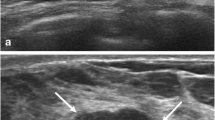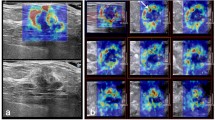Abstract
Objectives
Shear wave elastography (SWE) is a promising adjunct to greyscale ultrasound in differentiating benign from malignant breast masses. The purpose of this study was to characterise breast cancers which are not stiff on quantitative SWE, to elucidate potential sources of error in clinical application of SWE to evaluation of breast masses.
Methods
Three hundred and two consecutive patients examined by SWE who underwent immediate surgery for breast cancer were included. Characteristics of 280 lesions with suspicious SWE values (mean stiffness >50 kPa) were compared with 22 lesions with benign SWE values (<50 kPa). Statistical significance of the differences was assessed using non-parametric goodness-of-fit tests.
Results
Pure ductal carcinoma in situ (DCIS) masses were more often soft on SWE than masses representing invasive breast cancer. Invasive cancers that were soft were more frequently: histological grade 1, tubular subtype, ≤10 mm invasive size and detected at screening mammography. No significant differences were found with respect to the presence of invasive lobular cancer, vascular invasion, hormone and HER-2 receptor status. Lymph node positivity was less common in soft cancers.
Conclusion
Malignant breast masses classified as benign by quantitative SWE tend to have better prognostic features than those correctly classified as malignant.
Key points:
• Over 90 % of cancers assessable with ultrasound have a mean stiffness >50 kPa.
• ‘Soft’ invasive cancers are frequently small (≤10 mm), low grade and screen-detected.
• Pure DCIS masses are more often soft than invasive cancers (>40 %).
• Large symptomatic masses are better evaluated with SWE than small clinically occult lesions.
• When assessing small lesions, ‘softness’ should not raise the threshold for biopsy.


Similar content being viewed by others
References
Chang JM, Moon WK, Cho N, Yi A, Koo H, Han W et al (2012) Clinical application of shear wave elastography (SWE) in the diagnosis of benign and malignant breast diseases. Breast Cancer Res Treat 129:89–97
Berg W, Cosgrove D, Doré C, Schäfer F, Svensson W et al (2012) Shear-wave elastography improves the specificity of breast US: the BE1 multinational study of 939 masses. Radiology 262:435–449
Evans A, Whelehan P, Thomson K, Brauer K, Jordan L, Purdie C et al (2012) Differentiating benign from malignant solid breast masses: value of shear wave elastography according to lesion stiffness combined with gray scale ultrasound according to BI-RADS classification. Br J Cancer 107:224–229
Cosgrove D, Berg W, Doré C, Skyba D, Henry J, Gay J, Cohen-Bacrie C, BE1 Study Group (2012) Shear wave elastography for breast masses is highly reproducible. Eur Radiol 22:1023–1032
Evans A, Whelehan P, Thomson K, McLean D, Brauer K, Purdie C et al (2012) Invasive breast cancer: Relationships between Shear Wave Elastography Findings and Histological Prognostic Factors. Radiology 263:673–677
Chang JM, Park IA, Lee SH et al (2013) Stiffness of tumours measured by shear-wave elastography correlated with subtypes of breast cancer. Eur Radiol 23:2450–2458
Purdie CA, Jordan LB, McCullough JB, Edwards SL, Cunningham J, Walsh M et al (2010) HER2 assessment on core biopsy specimens using monoclonal antibody CB11 accurately determines HER2 status in breast carcinoma. Histopathology 56:702–707
NHS Breast Screening Programme (2005) Guidelines for pathology reporting in breast disease. NHSBSP Publication 58. Public Health England, London
Evans A, Whelehan P, Thomson K, McLean D, Brauer K, Purdie C et al (2010) Quantitative shear wave ultrasound elastography: initial experience in solid breast masses. Breast Cancer Res 12:R104
Yoon HY, Jung HK, Lee JT, Ko KH (2013) Shear-wave elastography in the diagnosis of solid breast masses: what leads to false-negative or false-positive results? Eur Radiol 23:2432–2440
Dhillon R, Depree P, Metcalf C, Wylie E (2006) Screen-detected mucinous breast carcinoma: potential for delayed diagnosis. Clin Radiol 61:423–430
Tozaki M, Fukuma E (2011) Pattern classification of shear wave elastography images for differential diagnosis between benign and malignant solid breast masses. Acta Radiol 52:1069–1075
Gweon HM, Youk JH, Son EJ, Kim J-A (2013) Visually assessed colour overlay features in shear-wave elastography for breast masses: quantification and diagnostic performance. Eur Radiol 23:658–663
Acknowledgements
The scientific guarantor of this publication is Professor Andrew Evans. The authors of this manuscript declare relationships with the company Supersonic Imagine. The authors state that this work has not received any funding. One of the authors has significant statistical expertise (Dr Steven Hubbard). Institutional Review Board approval was not required because the technique being evaluated is routine standard of care in our institution. Written informed consent was waived by the Institutional Review Board. However, written informed consent for the use of images was obtained. Some study subjects or cohorts have been previously reported in references 3 and 5 in the manuscript.
Methodology was a retrospective (data collected prospectively, analysed retrospectively), diagnostic or prognostic study, and performed at one institution.
Author information
Authors and Affiliations
Corresponding author
Rights and permissions
About this article
Cite this article
Vinnicombe, S.J., Whelehan, P., Thomson, K. et al. What are the characteristics of breast cancers misclassified as benign by quantitative ultrasound shear wave elastography?. Eur Radiol 24, 921–926 (2014). https://doi.org/10.1007/s00330-013-3079-4
Received:
Accepted:
Published:
Issue Date:
DOI: https://doi.org/10.1007/s00330-013-3079-4




